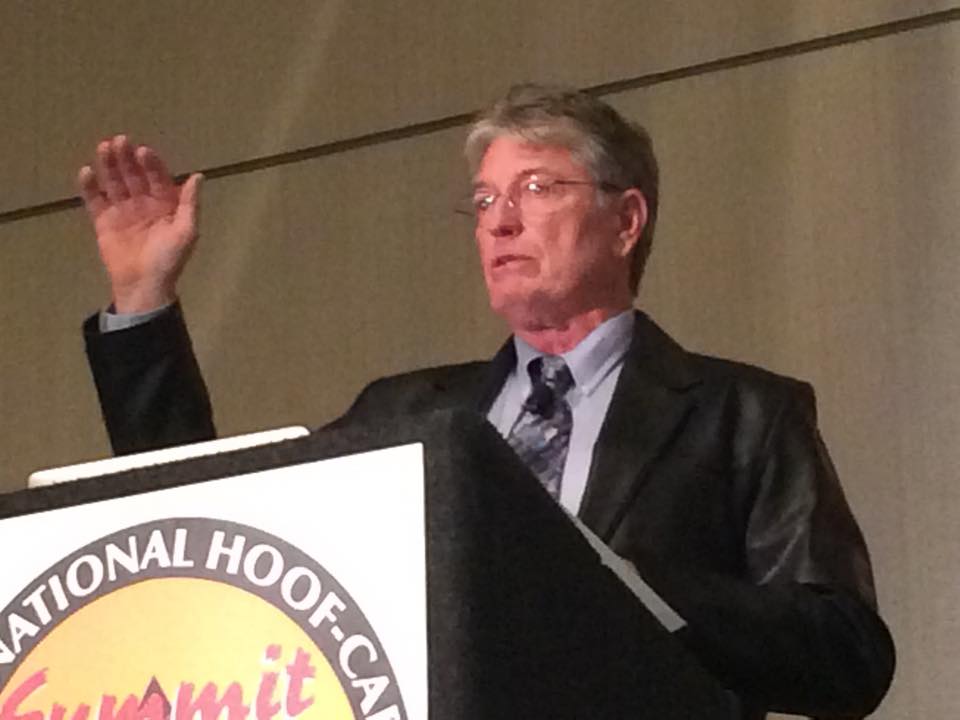Do you find yourself wondering why you’re not excelling in your farrier practice?
Coshocton, Ohio, farrier Dave Farley knows a thing or two about excelling.
He has been shoeing horses for about 40 years across a number of disciplines, including hunters and jumpers on the A Circuit. The American Farrier’s Association (AFA) recognized Farley as its Clinician of the Year for 2000. Topping an all too brief summary of his résumé, Farley also is a member of the International Horseshoeing Hall Of Fame.
Farley presented a lecture at the 44th annual AFA Convention in Overland Park, Kan., that focused on the differences between hunters, jumpers, dressage and eventers. While not every farrier shoes those disciplines, his advice holds up well for others.
Support The Disciplines
Each discipline that your client competes in should receive your support. Whether he was shoeing Quarter Horses, reiners or hunters and jumpers, Farley joined each association.
“You need to support those associations,” he says. “Your clients will respect you more for doing that. You’re just showing interest in continuing education for yourself.”
Immerse Yourself In The Discipline
Study every aspect of the disciplines that your clients’ horses compete in.
“We need to learn what these horses do, appreciate what they do and hang with somebody who knows what they do,” Farley says. “You should be more familiar with the sport horse. You can make better judgments when you shoe a particular discipline. With this information, you should be better prepared for your clients and the horses you shoe should perform better.”
Shoe Them Accordingly
 Dave Farley giving the closing remarks at the 2015 International Hoof-Care Summit in Cincinnati, Ohio.
Dave Farley giving the closing remarks at the 2015 International Hoof-Care Summit in Cincinnati, Ohio.
As show horses are moved to Florida for the winter, Farley invariably finds himself in an uncomfortable position.
“I have to defend farriers,” he says. “These horses are shod better than I can shoe them. They do very well shoeing these horses at home when they’re showing in dirt, sand or grass. When they show up in Wellington on this synthetic material, they fall apart and the first thing the owners want to do is fire them.”
He suggests anticipating the move and checking your ego at the door.
“Have an open mind and stop being so defensive,” Farley says. “Aluminum shoes are part of the industry. You have to get over it. You’re painting yourself into a corner if you don’t adjust your shoeing before the horse heads south. Learn what these horses are doing now and learn about the trainers, the footing and everything that’s going on.”
Educate Your Client
Once you have immersed yourself in the discipline, educate your clients about the differences in shoeing each one.
“If you don’t and they see a blue suede shoe on a dressage horse and you’ve got it on a jumper, they’re going to fire you,” he says. “You need to let them know that any horse can wear blue suede shoes. You need to educate them so they know you’re an expert.”
Knock Off The Clinches Correctly
Although the feet are shod beautifully, the clinching can leave something to be desired.
“The horses may have had one or two baths a week and within 3 or 4 days of arriving in Florida their feet fall apart because they look like they’ve been shot with 12-gauge buckshot. All the nails are being pulled without knocking the clinches off.”
As a result, water gets in the holes and the hoof wall swells.
“The clinches are like a knife blade,” Farley says. “When it comes through the foot, it takes everything underneath it and makes a bigger area for water to collect. File those clinches off, knock them off and then file them off so that the blade pulls through cleanly and doesn’t take the same thickness out with the clinch.”
What are your tips for excelling in your practice? Tell us by leaving a comment in the section below.








Post a comment
Report Abusive Comment